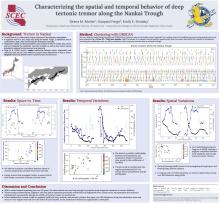Characterizing the spatial and temporal behavior of deep tectonic tremor along the Nankai Trough
Sirena M. Motter, Gaspard Farge, & Emily E. BrodskyPublished September 7, 2025, SCEC Contribution #14704, 2025 SCEC Annual Meeting Poster #035 (PDF)
Tectonic tremor is a weak seismic signal composed of several low-frequency earthquakes not felt on the surface. It occurs in the quiet periods between large earthquakes as plates slip slowly past each other deep in subduction zones, often in frequent and distinct episodes. Our research focuses on deep tremor beneath the Nankai Trough in southwestern Japan, where the Philippine Sea plate subducts below the Eurasian plate. This region has generated five magnitude 8+ earthquakes in the past 300 years, and has the longest and most complete record of tremor in the world, spanning 20 years. Tremor along the Nankai Trough forms very distinct “episodes” that propagate along strike. As tremor only began being documented in the early 2000s, the observations are now long enough to properly study their temporal variations. Analyzing the spatiotemporal behavior of tremor episodes reveals when, where, and how frequently a subduction zone fails, which is critical information for better forecasting catastrophic earthquakes.
We use a density-based clustering technique (DBSCAN) in Python to detect and isolate tremor episodes by creating clusters of neighboring events in space and time. This allows us to measure the periodicity, spatial extent, and recurrence interval of these distinct clusters in different regions along the trough, revealing how their behavior evolves over time and space. We also investigate how these properties evolve against each other, and how they vary due to external forces such as nearby earthquakes.
Over the twenty years of available data, we find the following relationships: (1) Cluster extents and their recurrence times are correlated, with larger clusters occurring less frequently. (2) Recurrence times in most regions remain remarkably regular throughout the timeframe. (3) Nearby earthquakes disrupt both the periodicity and the extent of tremor clusters; more seismic activity correlates to shorter and more irregularly occurring clusters. This indicates that local seismicity significantly influences how tremor events organize in time and space. For instance, we see very long and periodic tremor clusters in the Kii Peninsula region of Japan along the trough, a region with very little seismicity. These temporal observations together support the spatial patterns documented earlier by Farge et al. (2025) and reinforce the interpretation that tremor tends to synchronize into regular periodicities except where perturbed by regional seismicity.
Key Words
tectonic tremor, Nankai Trough, tremor recurrence
Citation
Motter, S. M., Farge, G., & Brodsky, E. E. (2025, 09). Characterizing the spatial and temporal behavior of deep tectonic tremor along the Nankai Trough. Poster Presentation at 2025 SCEC Annual Meeting.
Related Projects & Working Groups
Seismology




